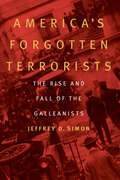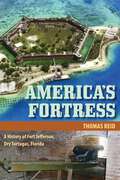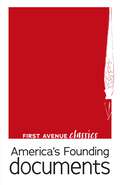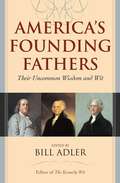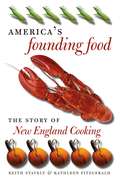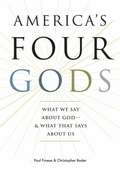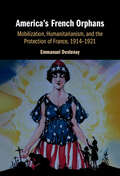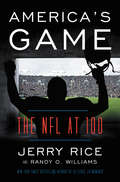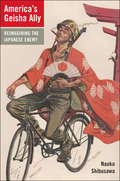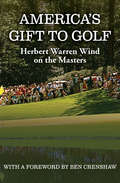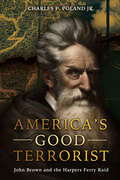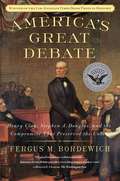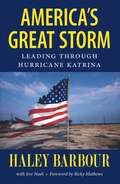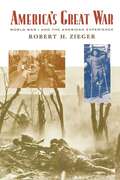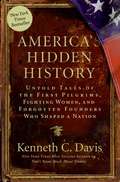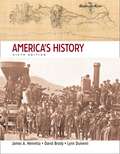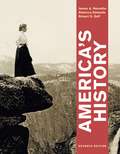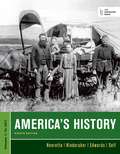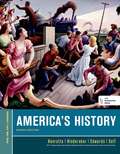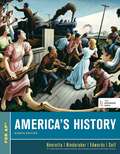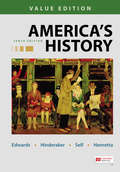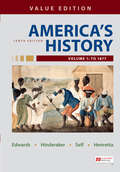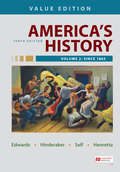- Table View
- List View
America's Forgotten Terrorists: The Rise and Fall of the Galleanists
by Jeffrey D. SimonThough largely forgotten today, one of the most destructive terrorist groups in the United States was the Galleanists, a fiery band of Italian anarchists active during the early 1900s. In America&’s Forgotten Terrorists, Jeffrey D. Simon shows how alienation and frustration among segments of a community were transformed into a militant extremist movement. Luigi Galleani, a gifted writer and speaker, tapped into widespread disappointment among Italian immigrants concerning their lives in America. Unemployment, low wages, long working hours, discrimination, and a poor quality of life made many Italian immigrants receptive to his words. The Galleanists introduced terrorist tactics and strategies that are still used today: they were the first group to send package bombs across the country and to exploit the media for their own advantage. One of their members is also suspected of launching the first vehicle bomb in the United States in 1920, considered the worst act of domestic terrorism until the 1995 Oklahoma City bombing. The story of the Galleanists is a chilling journey through a volatile period in American history, including labor-management conflicts, World War I, and the Red Scare. An expert in terrorism, Simon offers striking insights into the Galleanist era and some of its eerie connections to modern America, calling us to recognize the risks of repeating our history. How the Galleanists operated and how the U.S. government responded hold lessons for today as we continue to deal with the threat of terrorism.
America's Fortress: A History of Fort Jefferson, Dry Tortugas, Florida (Florida History and Culture)
by Thomas ReidA little-known Civil War outpost that was the most heavily armed coastal defense fort in United States historyKnown as the “American Gibraltar,” Fort Jefferson, located in the Dry Tortugas, Florida, was the most heavily armed coastal defense fort in United States history. Perceived as the nation’s leading maximum-security prison, the fort also held several of the accused conspirators in the Lincoln assassination. America’s Fortress is the first book-length, architectural, military, environmental, and political history of this strange and significant Florida landmark. This volume also fills a significant gap in Civil War history with regard to coastal defense strategy, support of the Confederacy blockade, the use of convicted Union soldiers as forced labor, and the treatment of civilian prisoners sentenced by military tribunals. Reid argues that Fort Jefferson’s troops faced very different threats and challenges than soldiers who served elsewhere during the war. He chronicles threats of epidemic tropical disease, hurricanes, shipwrecks, prisoner escapes, and Confederate attack. Reid also reports on white northerners’ perceptions of enslaved people, slavery, and the emerging free black soldiers of the latter years of the war. Drawing on the writings of Emily Holder, wife of Fort Jefferson’s resident surgeon, Reid is the first to offer a female perspective on life at the fort between 1859 and 1865. For history buffs and tourists, America's Fortress offers a fascinating account of this little-known outpost which has stood for over 160 years off the tip of the Florida Keys.
America's Founding Documents: The Declaration of Independence, the Articles of Confederation, the United States Constitution, the Federalist Papers, and the Bill of Rights (First Avenue Classics ™)
by Alexander Hamilton James Madison John Jay Thomas JeffersonSoon after the start of the American Revolutionary War in 1775, the Thirteen Colonies proclaimed their independence from British rule and became the United States of America. The written word proved vital in shaping America's new identity, laying the groundwork for societal principles and political doctrine alike. From Thomas Jefferson and the members of the Second Continental Congress, to Alexander Hamilton, James Madison, and John Jay, the authors of these documents had a profound and lasting effect on United States history. This collection includes unabridged versions of five famous and influential documents that helped to found a nation: the Declaration of Independence (1776), the Articles of Confederation (1777), the United States Constitution (1787), the Federalist Papers (1787–1788), and the Bill of Rights (1791).
America's Founding Fathers: Their Uncommon Wisdom and Wit
by Bill AdlerArguably, no other revolution in history has enjoyed such a brilliant gallery of thinkers as the one that led to the founding of the United States. America&’s Founding Fathers is centered on the personal philosophies, opinions, thoughts, witticisms, and feelings of the exemplary men who founded our nation. This book gathers together the founding fathers' best quotations on a variety of subjects including life, love, marriage, family, children, religion, patriotism, sacrifice, law, professionalism, medicine, public health, education, money, &“modern&” society, the Revolutionary War, humor, and death. Colleagues and rivals, friends and enemies, the eight founding fathers—Benjamin Franklin, George Washington, John Adams, Thomas Jefferson, Alexander Hamilton, James Madison, Benjamin Rush, and Thomas Paine—here provide their views on subjects as relevant now as ever.
America's Founding Food
by Kathleen Fitzgerald Keith StavelyFrom baked beans to apple cider, from clam chowder to pumpkin pie, Keith Stavely and Kathleen Fitzgerald's culinary history reveals the complex and colorful origins of New England foods and cookery. Featuring hosts of stories and recipes derived from generations of New Englanders of diverse backgrounds, America's Founding Food chronicles the region's cuisine, from the English settlers' first encounter with Indian corn in the early seventeenth century to the nostalgic marketing of New England dishes in the first half of the twentieth century.Focusing on the traditional foods of the region--including beans, pumpkins, seafood, meats, baked goods, and beverages such as cider and rum--the authors show how New Englanders procured, preserved, and prepared their sustaining dishes. Placing the New England culinary experience in the broader context of British and American history and culture, Stavely and Fitzgerald demonstrate the importance of New England's foods to the formation of American identity, while dispelling some of the myths arising from patriotic sentiment. At once a sharp assessment and a savory recollection, America's Founding Food sets out the rich story of the American dinner table and provides a new way to appreciate American history.
America's Four Gods: What We Say about God -- And What That Says about Us
by Christopher Bader Paul FroeseThis text draws on the most wide-ranging, comprehensive, and illuminating survey of American's religious beliefs ever conducted to offer a systematic exploration of how Americans view God.
America's French Orphans: Mobilization, Humanitarianism, and the Protection of France, 1914–1921
by Emmanuel DestenayDuring and after World War I, two humanitarian organizations galvanized the support of American men, women, and children to provide for France's children. Between 1914 and 1921, the Committee Franco-American for the Protection of the Children of the Frontier (CFAPCF) and the Fatherless Children of France Society (FCFS) capitalized on the generosity of Americans who believed that supporting a French child in need was seen as a moral and patriotic duty. Through a network of twenty-eight colonies – private homes and estates loaned for this specific purpose – the CFAPCF rescued, sheltered, and cared for children from invaded and occupied war zones, while the FCFS asked Americans to sponsor France's children of the war dead. Combining cultural, political, and diplomatic history, Emmanuel Destenay charts the rapid growth of these organizations and brings to light the unparalleled contribution made by Americans in support of France's children in time of war.
America's Game: The NFL at 100
by Jerry Rice Randy O. WilliamsA celebration of 100 years of the NFL from Hall of Fame receiver and bestselling author Jerry Rice!“This book is an amazing compilation of the game’s history as seen through the eyes of my friend Jerry Rice, aka The GOAT. You are going to love this book almost as much as you loved watching Jerry play!” —Barry Sanders, NFL Hall of Fame Class of 2004The authors of the New York Times bestseller 50 Years, 50 Moments celebrate the first 100 years of the National Football League, interweaving history, personal stories, memories, and observations of some of its greatest players, coaches, and advocates to chronicle football’s amazing evolution from a fledgling regional fly-by-night operation into a multi-billion global brand and one of America’s leading franchises.Over the past century, professional football has transformed from a game played in leather helmets on cow pastures to one of the most high-tech, popular sports on the planet. In this entertaining and concise history, Jerry Rice and Randy O. Williams celebrate the NFL’s centennial, bringing together colorful memories, insights, and personal experiences and observations from the heroes, losers, innovators, and defining legends who have played the game at its highest level. America's Game is filled with inside stories of the league’s fiercest rivalries, closest competitions, and most memorable characters, from the early days of Red “The Galloping Ghost” Grange and “Slingin’” Sammy Baugh to Jim Brown and “Broadway” Joe Namath to Lawrence Taylor, Jerry Rice, and Tom Brady.Cowboy fans will never forget how Roger Staubach’s Hail Mary lifted his team to a last-second playoff victory over the Vikings. Patriot followers will always point to The Tuck Rule Game as a franchise landmark where Adam Vinatieri’s two clutch kicks in deep snow propelled his team to victory over the Raiders. Generations of Steelers fans will celebrate James Harrison’s electrifying 100–yard interception return for a touchdown in Super Bowl XLIII. All are among the most memorable moments in NFL history. Divided by increments of twenty-five years, each section of America's Game includes the authors’ selections for their “All Star” players and teams.America's Game is a unique tribute to this enduring cultural phenomenon, and will become the authoritative tribute to all that is great about the sport Americans—and the world—loves.
America's Geisha Ally
by Naoko ShibusawaDuring World War II, Japan was vilified by America as our hated enemy. As the Cold War heated up, however, the U.S. government decided to make Japan its bulwark against communism in Asia. In this revelatory work, Naoko Shibusawa charts the remarkable reversal from hated enemy to valuable ally that occurred in the two decades after the war.
America's Gift to Golf: Herbert Warren Wind on the Masters
by Herbert Warren WindThe dean of American golf writers pays tribute to the nation&’s greatest tournament Over the course of his forty-year career at the New Yorker and Sports Illustrated, Herbert Warren Wind covered the game of golf from many different angles, providing readers with eloquent insights on the iconic courses of Scotland as well as Bing Crosby&’s lifelong love affair with the sport. But no aspect of golf was closer to Wind&’s heart, or more intimately associated with his name, than the annual Masters Tournament at Augusta National Golf Course. Recounting Arnold Palmer&’s victory in 1958, Wind coined the phrase &“Amen Corner&” to describe the fateful stretch of golf course including the 11th, 12th, and 13th holes. To celebrate the fiftieth anniversary of the first Augusta National Invitation, held in 1934, Wind eloquently recounted a half-century&’s worth of highlights, from Bobby Jones&’s original vision of an informal competition between his old friends and the game&’s rising stars, to Ben Crenshaw&’s impressive defeat of Tom Watson in the 1984 tournament. Full of the grand traditions—including green jackets, purple azaleas, and white jumpsuits—and dramatic moments that have made the Masters the most entertaining of the four major championships, America&’s Gift to Golf brings the history of this majestic tournament to vivid life and testifies to the enduring legacy of Herbert Warren Wind.
America's Good Terrorist: John Brown and the Harpers Ferry Raid
by Charles P. Poland Jr.<p>A biography of John Brown, examining his failed raid on Harpers Ferry, and the part his actions played in causing the Civil War.<p> <p>John Brown’s failed efforts at Harpers Ferry have left an imprint upon our history, and his story still swirls in controversy. Was he a madman who felt his violent solution to slavery was ordained by Providence or a heroic freedom fighter who tried to liberate the downtrodden slave? These polar opposite characterizations of the violent abolitionist have captivated Americans. The prevailing view from the time of the raid to well into the twentieth century—that his actions were the product of an unbalanced mind—has shifted to the idea that he committed courageous acts to undo a terrible injustice.<p> <p>Despite the differences between modern terrorist acts and Brown’s own violent acts, when Brown’s characteristics are compared to the definition of terrorism as set forth by scholars of terrorism, he fits the profile. Nevertheless, today Brown is a martyred hero who gave his life attempting to terminate the evil institution of human bondage. The modern view of Brown has unintentionally made him a “good terrorist,” despite the repugnance of terrorism that makes the thought of a benevolent or good terrorist an oxymoron.<p> <p>This biography covers Brown’s background and the context to his decision to carry out the raid, a detailed narrative of the raid and its consequences for both those involved and America; and an exploration of the changing characterization of Brown since his death.<p>
America's Great Debate: Henry Clay, Stephen A. Douglas, and the Compromise That Preserved the Union
by Fergus M. BordewichThe Mexican War introduced vast new territories into the United States, among them California and the present-day Southwest. When gold was discovered in California in the great Gold Rush of 1849, the population swelled, and settlers petitioned for admission to the Union. But the U.S. Senate was precariously balanced with fifteen free states and fifteen slave states. Up to then states had been admitted in pairs, one free and one slave, to preserve that tenuous balance in the Senate. Would California be free or slave? So began a paralyzing crisis in American government, and the longest debate in Senate history. Fergus Bordewich tells the epic story of the Compromise of 1850 with skill and vigor, bringing to life two generations of senators who dominated the great debate. Luminaries such as John Calhoun, Daniel Webster, and Henry Clay—who tried unsuccessfully to cobble together a compromise that would allow for California’s admission and simultaneously put an end to the nation’s agony over slavery—were nearing the end of their long careers. Rising stars such as Jefferson Davis, William Seward, and Stephen Douglas—who ultimately succeeded where Clay failed—would shape the country’s politics as slavery gradually fractured the nation. The Compromise saved the Union from collapse, but it did so at a great cost. The gulf between North and South over slavery widened with the strengthened Fugitive Slave Law that was part of the complex Compromise. In America’s Great Debate Fergus Bordewich takes us back to a time when compromise was imperative, when men swayed one another in Congress with the power of their ideas and their rhetoric, when partisans on each side reached across the aisle to preserve the Union from tragedy.
America's Great Storm: Leading through Hurricane Katrina
by Haley BarbourWhen Hurricane Katrina hit Mississippi on August 29, 2005, it unleashed the costliest natural disaster in American history, and the third deadliest. Haley Barbour had been Mississippi's governor for only twenty months when he assumed responsibility for guiding his pummeled, stricken state's recovery and rebuilding efforts. America's Great Storm is not only a personal memoir of his role in that recovery, but also a sifting of the many lessons he learned about leadership in a time of massive crisis. For the book, the authors interviewed more than forty-five key people involved in helping Mississippi recover, including local, state, and federal officials as well as private citizens who played pivotal roles in the weeks and months following Katrina's landfall. In addition to covering in detail the events of September and October 2005, chapters focus on the special legislative session that allowed casinos to build on shore; the role of the recovery commission chaired by Jim Barksdale; a behind-the-scenes description of working with Congress to pass an unprecedented, multi-billion-dollar emergency disaster assistance appropriation; and the enormous roles played by volunteers in rebuilding the entire housing, transportation, and education infrastructure of South Mississippi and the Gulf Coast. A final chapter analyzes the leadership skills and strategies Barbour employed on behalf of the people of his state, observations that will be valuable to anyone tasked with managing in a crisis.
America's Great War: World War I and the American Experience (Critical Issues In American History)
by Robert H. ZiegerRecent bestsellers by Niall Ferguson and John Keegan have created tremendous popular interest in World War I. In America's Great War prominent historian Robert H. Zieger examines the causes, prosecution, and legacy of this bloody conflict from a frequently overlooked perspective, that of American involvement. <p><p> This is the first book to illuminate both America's dramatic influence on the war and the war's considerable impact upon our nation. Zieger's engaging narrative provides vivid descriptions of the famous battles and diplomatic maneuvering, while also chronicling America's rise to prominence within the postwar world. On the domestic front, Zieger details how the war forever altered American politics and society by creating the National Security State, generating powerful new instruments of social control, bringing about innovative labor and social welfare programs, and redefining civil liberties and race relations. America's Great War promises to become the definitive history of America and World War I.
America's Hidden History
by Kenneth C. DavisKenneth C. Davis, author of the phenomenal New York Times bestseller Don't Know Much About History, presents a collection of extraordinary stories, each detailing an overlooked episode that shaped the nation's destiny and character. Davis's dramatic narratives set the record straight, busting myths and bringing to light little-known but fascinating facts from a time when the nation's fate hung in the balance. Spanning a period from the Spanish arrival in America to George Washington's inauguration in 1789, America's Hidden History details these episodes, among others: The story of the first real Pilgrims in America, who were wine-making French Huguenots, not dour English Separatists The coming-of-age story of Queen Isabella, who suggested that Columbus pack the moving mess hall of pigs that may have spread disease to many Native Americans The long, bloody relationship between the Pilgrims and Indians that runs counter to the idyllic scene of the Thanksgiving feast The little-known story of George Washington as a headstrong young soldier who committed a war crime, signed a confession, and started a war! Full of color, intrigue, and human interest, America's Hidden History is an iconoclastic look at America's past, connecting some of the dots between history and today's headlines, proving why Davis is truly America's Teacher.
America's History
by James A. Henretta Lynn Dumenil David BrodyIn order for students to succeed in an AP U. S. history course, they need to understand not only what happened, but also why it happened. "America's History" has long been praised as a text that helps students to think critically about history and analyze both how and why historical events have occurred. "America's History" deftly weaves together political, social, and cultural history in a narrative that students find accessible and engaging. Exceptional pedagogical support -- overviews, maps, figures, illustrations, and embedded documents -- are carefully integrated to encourage the development of students' historical skills. "America's History" is the text that covers not only the facts, but also the skills that students need to have success in the AP U. S. history course. Need help with the audit? Click here to download an AP correlation.
America's History (7th Edition)
by James A. Henretta Rebecca Edwards Robert O. SelfAmerica's History helps students understand the world in which we live, by drawing links between events in the United States and those elsewhere.
America's History (Eighth Edition): Volume One: To 1877
by James A. Henretta Rebecca Edwards Robert O. SelfKnown for its interpretive voice and thoughtful analysis, America's History models exactly the kind of thinking and writing students need to be successful. An accessible and balanced narrative with built-in primary sources and skills-based pedagogy gives students practice in thinking historically, and features new ways of mastering the content so that students come to class prepared. The eighth edition rolls out Bedford/St. Martin's new digital history tools, including LearningCurve, an adaptive quizzing engine that garners over a 90% student satisfaction rate, and LaunchPad, the all new interactive e-book and course space that puts high quality easy-to-use assessment at your fingertips. Easy to integrate into your campus LMS, and featuring video, additional primary sources, a wealth of adaptive and summative quizzing, and more, LaunchPad cements student understanding of the text while helping them make progress toward learning outcomes. It's the best content joined up with the best technology.
America's History for the AP Course
by James A. Henretta Rebecca Edwards Robert O. Self Eric HinderakerAmerica's History offers a thematic approach and skills-oriented pedagogy that helps students succeed in the redesigned AP U. S. History course. Known for its attention to AP themes and content, the new edition features a new nine part structure closely aligned with the chronology of the new AP U. S. History course, an expanded documents program, LearningCurve--an online adaptive learning tool that reinforces students' reading--and a wealth of supporting resources and digital options that give teachers and students the tools they need to master the course and the new exam. View a sample chapter. *AP is a trademark registered and/or owned by the College Board, which was not involved in the production of, and does not endorse, this product.
America's History for the AP® Course
by James A. Henretta Rebecca Edwards Eric HinderakerAmerica's History offers a thematic approach and skills-oriented pedagogy that helps students succeed in the redesigned AP U.S. History course. Known for its attention to AP themes and content, the new edition features a new nine part structure closely aligned with the chronology of the new AP U.S. History course, an expanded documents program, LearningCurve--an online adaptive learning tool that reinforces students' reading--and a wealth of supporting resources and digital options that give teachers and students the tools they need to master the course and the new exam.
America's History for the AP® Course
by Rebecca Edwards Eric Hinderaker James Henretta Robert SelfNIMAC-sourced textbook
America's History, Sixth Edition
by James A. Henretta Lynn Dumenil David BrodyHigh School AP U.S. history textbook
America's History, Value Edition, Combined Volume: 2 Books Set
by Rebecca Edwards Eric Hinderaker James Henretta Robert SelfAmerica’s History explains WHY events occurred, not just when. Students are provided an analytical and big-picture approach to American history in an affordable format.
America's History, Value Edition, Volume 1: 2 Books Set
by Rebecca Edwards Eric Hinderaker James Henretta Robert SelfAmerica’s History explains WHY events occurred, not just when. Students are provided an analytical and big-picture approach to American history in an affordable format.
America's History, Value Edition, Volume 2: 2 Books Set
by Rebecca Edwards Eric Hinderaker James Henretta Robert SelfAmerica’s History explains WHY events occurred, not just when. Students are provided an analytical and big-picture approach to American history in an affordable format.
